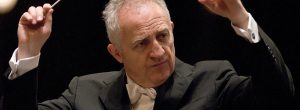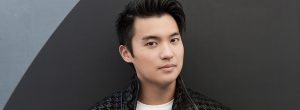‘TWAS BRILLIG, AND THE SLITHY TOVEY
The witty, charming raconteur and conductor Bramwell Tovey has never failed to have the audience in the palm of his baton-filled hand. As energetic and high-spirited as ever, Tovey, the former Los Angeles Philharmonic principal guest conductor at the Hollywood Bowl, led us on a journey as disparate as the three selections on last night’s program at Disney Hall: Walton’s Façade Suite No. 2 was superfluous but an absolute joy; violinist Ray Chen’s rendering of Sibelius’ Violin Concerto proved the 27-year-old Taiwanese Australian as one to watch but who needs tempering; and, in the program’s second half, Act II of Tchaikovsky’s The Sleeping Beauty was perfectly rendered but an odd choice given the number of languorous passages in the selection.
Jean Sibelius wanted badly to be a violinist before he turned to composing; his 1903 Violin Concerto is so challenging that I wonder if it was some kind of revenge on violinists. There are fast runs, arpeggios across all four strings, tricky harmonics, and a notorious passage of staccato double-stops. Chen gave a powerhouse performance and conquered the technically challenging aspects with extraordinary technique: he finished phrases with a flourish; he offered impressively solid trills; and in the very first bars–when a simple violin line rises out of an almost inaudible background in the strings–his volume was remarkable. Chen’s manner is infectious; he has youth, vigor, and vitality on his side. His muscular bowing was matched by the sinuous way his body arched backward.
But a sort of youthful exuberance, maybe a need to please (this was, after all, Chen’s Walt Disney Concert Hall debut), got the best of him a few times: Tovey led the tight and rightfully understated players like a gentleman, glancing at Chen many times, but the violinist fell out of tempo with the orchestra more than once. He was ferocious and sweating, but at one point his shoulder rest fell to the floor. And while he seemed to be soaring in his mind among the peaks of Scandinavian fjords, there was an emotional disconnect with the music, which sometimes resulted in unconvincing long notes. In other words, he occasionally played the violin but not always the concerto.
Yet when the virtuosic and athletic Chen, playing his 1715 “Joachim” Stradivarius, produced an encore of Paganini’s Caprice No. 21, his enthusiasm, wit, tenderness, and proficiency won the day. Here he is doing the same encore after a performance with the Gothenburg Symphony Orchestra:
Introducing Sleeping Beauty with a microphone, Tovey elucidated and explicated his journey with, and why he chose, Act II. Most notable was his absolute fear when he first conducted the ballet with Rudolph Nureyev performing; he enjoys conducting Act II because it doesn’t require synced precision with dancers. In his usual droll sensibility, the 63-year-old cunning communicator pointed out that percussionist Matthew Howard had one job: to bang a gong at the end. (Tovey also adroitly blessed a sneezing patron sitting up in the terrace.)
The Sleeping Beauty is filled with a continuous stream of beautiful, richly orchestrated music. Although beloved when presented on stage as a ballet, it clearly can be listened to and enjoyed as a beautiful symphonic poem; it’s a nonstop flow of inspired melodies, both graceful and dramatic. Basically constructed like a four-movement symphony, Beauty also enjoys the distinction of being the longest piece of music Tchaikovsky ever wrote (Act II comes in at just under fifty minutes). But the gorgeous, dramatic score is quite subdued at times, and without visuals–and even though we had supertitles explaining the action–there are times I felt as though I pricked my finger on the spindle of a spinning wheel.
Nonetheless, there was a true fairy-tale richness and delicacy given to the score–especially with Lou Anne Neill’s graceful harp playing. The most exciting aspect was the cello section, who dug in unlike any interpretation I have ever heard; Principal player Robert deMaine beautifully executed his solo in the vision scene (Pas d’action) with rich-bodied sound and mood. Also noteworthy was the opening oboe theme, played with tender restraint by Marion Arthur Kuszyk, and Concertmaster Martin Chalifour’s Entr‘acte violin solo, originally intended for and then cut from the original production of Sleeping Beauty. Tovey’s performance was subtle, enchanting, and lovely. His reputation as a reliable conductor and witty annotator always makes me forget just what a ferocious awe-inducing maestro extraordinaire he truly is.
Surprisingly, my favorite part of the night was the appetizer. William Walton actually conducted LA Phil’s first performance of his Façade Suite No. 2 in 1953. The 10-minute 6-part suite from 1938 is frivolously fun; a smaller 1922 version was originally constructed to accompany Edith Sitwell reciting her Façade poems. The flavor of some selections bore resemblance to their title. “Scotch Rhapsody” and “Country Dance” showcased the reeds (Denis Bouriakov, flute; Burt Hara, clarinet; Sarah Jackson, Piccolo). “Noche Española” had a slow tango with castanets that built in speed. Ragtime clearly inspired “Popular Song” and “Old Sir Faulk”, the latter a combination of syncopation, clip-clopping, and a soft jazz that would evolve into Gershwin’s early work. A delightful entertainment.
photos courtesy of LA Phil
Los Angeles Philharmonic
Bramwell Tovey, conductor
Ray Chen, violin
Walt Disney Concert Hall
ends on January 8, 2017
for tickets, call 323.850.2000 or visit LA Phil



